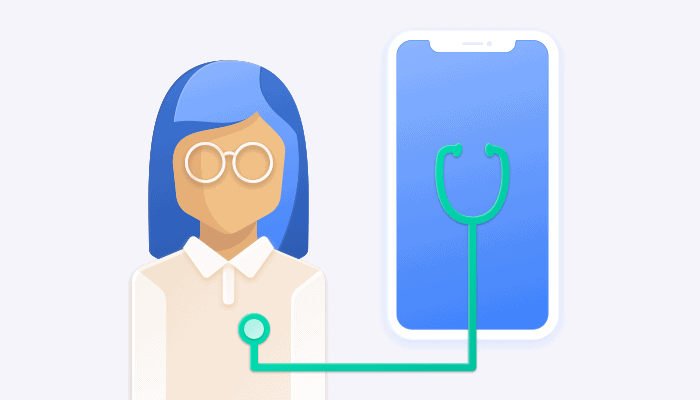
The outbreak of coronavirus disease-19 (COVID-19) has become a challenge for health systems around the world. Physicians are faced with an unprecedented workload, as ensuring primary healthcare during this pandemic appeared to be a significant challenge. Telehealth solutions to fight the COVID-19 outbreak become more relevant than ever. While the pandemic disrupts the healthcare system, telehealth has provided an enabling tool to help medical providers better respond to peoples’ needs, minimize virus spread, and ensure healthcare professionals’ efficient time-use.
Telehealth as a service is based on digital technologies to provide medical care at a distance and connect doctors. The capabilities of telehealth solutions are known and have been developing for a relatively long time. It allows expanding healthcare services in remote regions, providing patients with private consultations in non-urgent situations, conducting online consultations – and these are just a few of its advantages. Even before the pandemic, Statista predicted that the telehealth market size would increase to $41.2 billion by 2021.
Telehealth during the COVID-19
The COVID-19 pandemic made us face telehealth platforms from a new angle and significantly accelerated its implementation worldwide. The essential condition for containing the virus was the limitation of social contacts. Telehealth software allows people with mild symptoms to avoid visiting a doctor and receive help remotely. With the spread of the virus, advanced telehealth solutions have three-faceted significance.
- Patients who suspect they have COVID-19 may not endanger others by visiting a doctor.
- Patients with chronic conditions who need to keep their regular health care appointments can arrange a telehealth appointment and limit their contacts.
- The health care providers during this challenging time are at the highest risk. Many of them become infected from patients; others are forced to quarantine after contact with patients who have confirmed the diagnosis. All this puts a strain on clinics and the health care system in general. The adoption of telehealth solutions significantly reduces the number of dangerous interactions for doctors.
Implementing telehealth during the COVID-19
Both major healthcare technology companies and medical startups have mobilized to fight the pandemic. Since the outbreak, the Chinese telemedicine company JD Health has tenfold more monthly consultations, giving free consultations to 60 million Chinese citizens living abroad. Investors have seen dramatic share price increases between 33% and 74% in some of the largest online healthcare providers, Ping An Healthcare and Ali Health. Tencent offers the WeDoctor telehealth platform, and it has partnered with the British startup Babylon they have integrated AI and telehealth technologies into its solution.
Telemedicine companies in the United States also see a growing demand for their services. An example of a successful technology created by a startup is the Curates’s telemedicine platform used in the United States. The solution enables doctors to provide audio and video consultations, sync with FDA-approved Bluetooth gadgets, and integrate with American citizens’ electronic medical records.
Today, even as restrictions are canceled, fewer than 20% of non-emergency visits are happening in the clinic. Centers for Disease Control and Prevention are still urging medical care providers to use telehealth during COVID-19 as much as possible.
While most hospitals still struggle to provide telemedicine services, things are starting to change rapidly. Telehealth solutions can sort patients remotely; they can help first aid specialists connect with hospitals, allowing them to receive treatment quickly and efficiently. New technologies have the potential to expand the ability to monitor patients in any condition. The development of image analyzers programs that will measure body temperature and heart rates from several meters is underway. AI can use the collected data to predict changes in a person’s condition much earlier than a nurse does. The remote monitoring system allows assigning a treatment plan online.
Even though telehealth cannot solve all the problems now, the pandemic forces us to look closely at new developments and use some of them to strengthen health systems in the future. The current situation has shown telemedicine’s viability and demonstrated that there are situations when it is simply irreplaceable. The challenging experience that the whole world is going through today turns the idea of telemedicine upside down and makes the entire world finally take it seriously. Right now, the potential of this area can be fully revealed. There is no doubt that telehealth will play a role in the fight against the COVID-19 pandemic and will be the key to creating future medicine.
Meanwhile, non-emergency departments and physicians need to adopt telehealth solutions to their practices. Telemedicine is a way to stay in touch safely with your patients and could be the key to be upfront to personal care in the future.
What does QuickBlox offer?
What are the suggestions? Technological improvements make it possible to quickly deploy video chat services, in-app voice calls, and messaging features to the medical practice to allow comprehensive virtual visits for the foreseeable future.
QuickBlox offers the HIPAA compliant Q-Consultation application for telehealth. Healthcare providers deal with protected health information (PHI) of their patients to give them professional assistance. According to HIPAA regulations, they must respect national health data privacy and security requirements when it comes to any data, including video. QuickBlox’sQuickBlox’s HIPAA video conferencing solution Q-Consultation meets security rule standards and allows medical professionals to provide an efficient patient care level remotely, improving the clients’ experience. QuickBlox also provides HIPAA compliant cloud services, so the full stack allows it to operate safely in any sphere that legally requires a HIPAA compliance software.
Suppose you have an idea of launching a telehealth solution for remote doctor-patient communication, with such modern features like high-quality video/audio capabilities and a built-in chat app. Scheduling appointments, sending follow-up reminders, sharing files, and screen sharing for collaborating with other patients care team members, Q-Consultation provides an opportunity. It comes as a Web application that can be customized and deployed to provide a fully-featured virtual room experience, addressing any business issue that requires rich audio/video and private chatting app capabilities with a queue of people.
Are you interested in the right telehealth solution that can meet modern concerns and security rules standards without compromising the quality and accessibility of care while saving you time and money? Contact Quickblox to discuss details.






